None
Most users ever online was 387 on Tue Dec 05, 2023 7:35 pm
The newest registered user is Skylines3
Our users have posted a total of 47502 messages in 4941 subjects
| No user |
• The FREE hand reading services at the Modern Hand Reading Forum are being continued in 2019 with the assistance of Google adsense!

Learn how to read hands according the Modern Hand Reading paradigm & you can use this forum as your palm reading guide!
Is this a comb pattern or no pattern in mercury mount
Modern Hand Reading Forum - Discover the language of your hands: palm reading & palmistry forum! :: III - MODERN HAND READING - Various systems for reading hands! :: IIIa - Modern Palmistry: general topics, questions :: IIIg - Dermatoglyphics + fingerprints
Page 2 of 3 •  1, 2, 3
1, 2, 3 
 Re: Is this a comb pattern or no pattern in mercury mount
Re: Is this a comb pattern or no pattern in mercury mount
Last edited by Patti on Fri May 03, 2013 7:15 pm; edited 1 time in total

Patti- Posts : 3912
Join date : 2010-07-24
 Re: Is this a comb pattern or no pattern in mercury mount
Re: Is this a comb pattern or no pattern in mercury mount
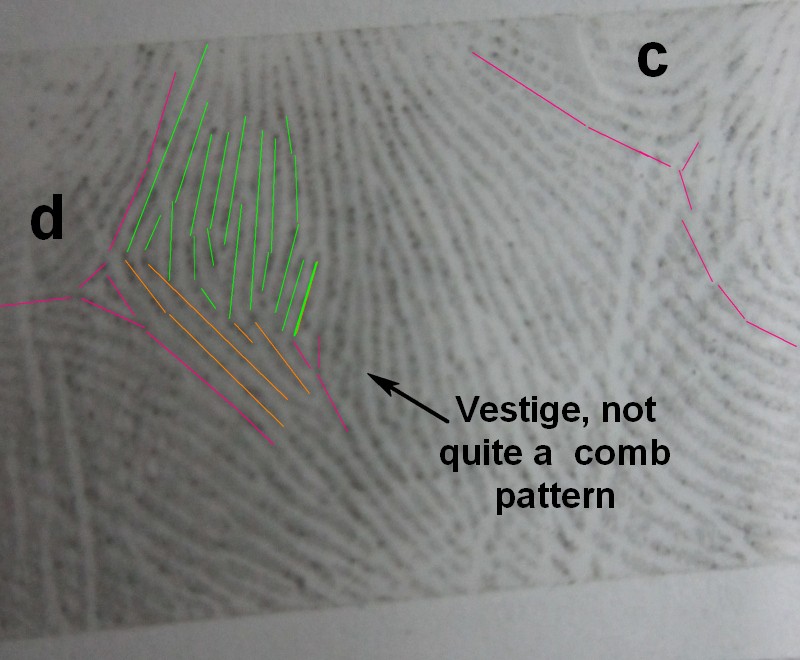
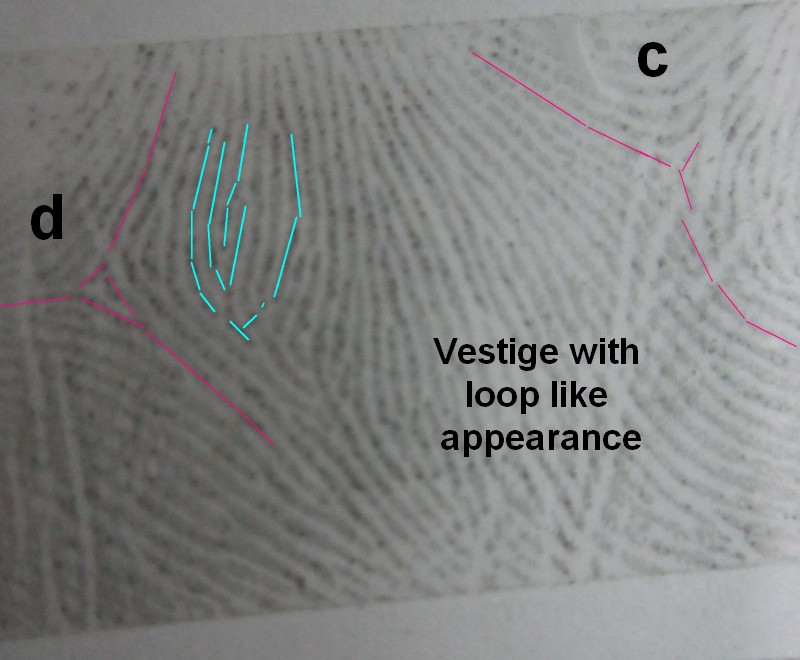

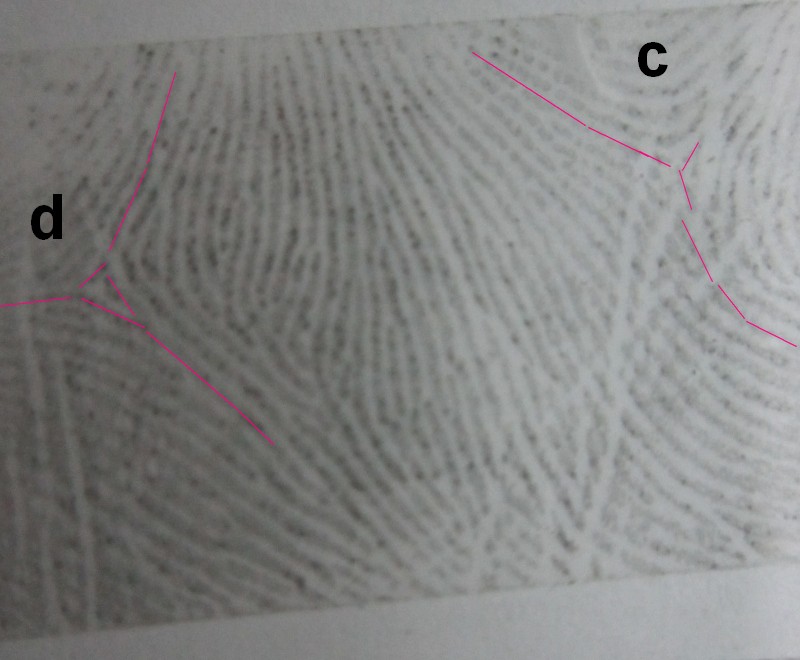
The reason I would call it a vestige is illustrated above. It does not conform to a loop or a comb pattern, however, it is not simply an Open Field and the remnants of patterns can be determined easily.
Last edited by Patti on Fri May 03, 2013 7:33 pm; edited 1 time in total (Reason for editing : added additional graphic)

Patti- Posts : 3912
Join date : 2010-07-24
 Re: Is this a comb pattern or no pattern in mercury mount
Re: Is this a comb pattern or no pattern in mercury mount
Patti, first of all: thank you for your efforts to explain the basis of your earlier shared perceptions.
Unfortunately, I can hardly confirm any of your observations. Because, if we take a closer look at the essence of a 'vestige' we see is that it represents "a local disarrangement in the parallel course of the ridges" (quoted from Loesch in 'Quantative Dermatoglyphics', 1983) - which is a similar definition to the description presented by Cummins & Midlo.
But this implicates that one can only speak of a 'vestige' when the ridge fields at all sides outside the "local disarrangement" have a different than the area concerned; the example below shows that the vestige area has a different direction than seen in all 4 surrounding ridge fields.

But Anand's example does not have such a phenomenon at all, because all ridge fields basically follow the same direction (see my picture below which is featured with the similar ridges in both of Anand's pictures)... and thus I can only conclude that it can not be vestige.

And regarding Anand's 'comb'-idea:
Loesch defined the 'comb' as: "Comb - a formation in which three or more parallel ridges join another ridge almost at right angles to their direction."
And thus I can only conclude that Anand's example does not display any characteristic that can be associated with a 'comb', because his example basically only includes parallel ridges (plus some terminating + forking ridges): see my illustration below, where I have marked the visible ridges in BOTH of Anand's pictures.
PS. Patti, your third picture indicates that you have completely misunderstood the essence of a 'vestige', because your picture suggests that the 4 green lines represent a 'vestige'... but those 4 ridges represent nothing more than a perfectly normal directed 'ridge field' that actually sort of has the same direction as all surrounding ridge fields (excluding the effects on the ridge direction due to the location of the pinky triradius of course).

Last edited by Martijn (admin) on Sat May 04, 2013 12:09 am; edited 1 time in total
 Re: Is this a comb pattern or no pattern in mercury mount
Re: Is this a comb pattern or no pattern in mercury mount
PPS. Patti, after our earlier discussions... it is very hard for me to see you drawing in the lower section of your second picture the light blue dot plus the light blue ridge part (which both together suggest that they make together a ridge that crosses a continued ridge line - which is basically not possible).
Your 2nd illustration for Anand's second picture:

Because if we take a closer look at the other picture presented by Anand (the one that you did not use in your illustrations... even though I could argue that this other picture is of a better quality), then we can see that your blue 'dot' + the blue 'ridge part' are not present in the other picture!
It's quite frustrating to see you making this beginner-like type of mistake... because it appears to me that you didn't even check out whether your light blue 'dot' + 'ridge part' are also present in the other picture (which is unfortunately not the case at all... and thus there is no basis to put any value on those details in the picture that you used).
Though when I take a look at the definitions for a 'vestige' and a 'comb' as presented by Cummins & Midlo and by Loesch... I recognize that such minutiue details are actually even quite irrelevant regarding the question whether Anand's example is a 'vestige' or an 'open field' (I observe that both pictures indicate that it is just an 'open field' between the triradii below the pinky and the ring finger).
NOTICE: Only the triradius below the pinky is visible in Anand's first picture.

 Re: Is this a comb pattern or no pattern in mercury mount
Re: Is this a comb pattern or no pattern in mercury mount

I think the appearance of a vestige is even more visible in this image.
One shouldn't make a "mountain out of a molehill" and the vestige is just a molehill. There are no hard core rules as it can even be something that has the appearance of a pattern, but isn't. Cummins & Midlo list several possibilites, these qualities are not expected to be found in all vestiges. It doesn't have to conform to rules at all - that's the whole point, it looks like a pattern but doesn't fit the rules for the pattern.
What Anand calls a "shape" is what Cummins and Midlo call a "conspicuous local disarrangement of ridges". It's obvious that there is a convergence of ridges in a small area. This is what Loesch refers to as a "cusp" ("Quantitative Dermatoglyphics" Loesch) a fanning of ridges that has a relationship to both the triradius and loop formations. That alone can make it a vestige according to Cummins & Midlo.
I'm sticking with my first response. It looks like a vestige leaning towards a comb.
I see where Loesch describes the 'cusp' but nothing about a vestige. Can you quote from your source?
From Penrose "An area without a loop or triradius is known as an arch on the finger tip or an arc on the palm or sole. Such a region may carry markings that are not regarded as true patterns, such as fan or ladder formations, and these are sometimes separately recorded in descriptions, especially on the area at the base of the thumb." ("Dermatoglyphics and Medicine" Lionel S. Penrose)
The 'bee' is more common on the upper thenar mount, but this sort of configuration we are looking at here, and the comb, are more commonly found in the interdigital area between the ring and little fingers.
Beginner's mistakes?

Patti- Posts : 3912
Join date : 2010-07-24
 Re: Is this a comb pattern or no pattern in mercury mount
Re: Is this a comb pattern or no pattern in mercury mount
anand_palm wrote:Hello Patti
Thanks for the defintion and input, so it looks there was some kind of approach towards a pattern formation during the devlopement of ridges then suddenly it stopped which implies that some indication of pattern was forming and stopped defintely a tendency towards a pattern formation is there. So under palmistry what kind of meanign should be given for such kind of occurences in mercury mount, like you cannot say totoally it is pattern nor can we say complete formation of triradius.
Also i will post few more pattern which i have doubts about classification.
Anand
Here's a letter to a medical publication's editor suggesting a change in the choice of word for vestige to "anteform".
http://europepmc.org/articles/PMC1685262/pdf/ajhg00206-0088.pdf
"TERMINOLOGY IN DERMATOGLYPHICS
To the Editor: In dermatoglyphics, it has been customary to use the term vestige to
refer to a developing and frequently discernible preconfiguration on the palm and the
sole. Cummins and Midlo [1] described these dermatoglyphic phenomena as "conspicuous local disarrangements of ridges, not conforming to the definition of a true
pattern but suggesting an approach toward the construction of a pattern." The word
vestige, however, connotes a remaining trace of something not developing but
deteriorating. In the light of this, we submit that vestige is a misnomer and that a more
accurate term be substituted for it. We suggest the word anteform to denominate this
transient configuration.
LESLIE Y. MORGAN
RICHARD C. JUBERG
Birth Dejects Center, Department of Pediatrics
Louisiana State University School of Medicine
Shreveport, Louisiana 71130

Patti- Posts : 3912
Join date : 2010-07-24
 Re: Is this a comb pattern or no pattern in mercury mount
Re: Is this a comb pattern or no pattern in mercury mount
V, Vestige a local disturbance of ridge direction,
such as a local rectilinear system having a direction
different from the region which it adjoins, an abrupt
convergence of ridges, etc. A vestige, as here formu-
lated, has no definable relation to a particular type
of true pattern (L, W or S, see below). The term
vestige is not intended to imply an actual evolutionary
status.

Patti- Posts : 3912
Join date : 2010-07-24
 Re: Is this a comb pattern or no pattern in mercury mount
Re: Is this a comb pattern or no pattern in mercury mount
Patti wrote:
I think the appearance of a vestige is even more visible in this image.
Nonsense, because Cummins & Midlo describe on page 103 that a vestige can manifest in two types of manifestation: 1) "a local disarrangement of ridges which converge abruptly", or 2) "a system of straight and parallel ridges which differ in direction from those surrounding the vestige area".
In Anand's example there is no ridge system which "converge abruptly" and there is also no evidence of a ridge system that shows a change of direction compared to the surrounding ridge systems. And thus there is no vestige.
Patti wrote:One shouldn't make a "mountain out of a molehill" and the vestige is just a molehill. There are no hard core rules as it can even be something that has the appearance of a pattern, but isn't. Cummins & Midlo list several possibilites, these qualities are not expected to be found in all vestiges. It doesn't have to conform to rules at all - that's the whole point, it looks like a pattern but doesn't fit the rules for the pattern.
Nonsense, you are misleadingly suggesting here that 'vestiges' have no clearly identifiable characteristics; but that is not true at all. The definitions shared by Cummins & Midlo and Loesch present the evidence that 'vestiges' do require to have certain characteristics (and 'cushioning' or a 'cusp' is not enough to call it a vestige because those phenomena are not even mentioned in the definitions).
So you completely misunderstood the vocabulary used by Cummins & Midlo; because on page 100 we can actually read that the 'vestige' does have a unique status as one of the 'primary configuration type' (the fact that a vestige is not recognized as a 'true pattern' is only a matter of definition).
Patti wrote:What Anand calls a "shape" is what Cummins and Midlo call a "conspicuous local disarrangement of ridges". It's obvious that there is a convergence of ridges in a small area. This is what Loesch refers to as a "cusp" ("Quantitative Dermatoglyphics" Loesch) a fanning of ridges that has a relationship to both the triradius and loop formations. That alone can make it a vestige according to Cummins & Midlo.
Anand's example does show 'cushioning' ridges; and this phenomena predisposes against the development of loops and whorls. But 'cushioning' should not be recognized as a primary type of configuration itself, because it is known as fenomena related to the level of the so-called minutiae. On page 13 in the work of Loesch figure 2.6c shows explicitely why 'cushioning' is not recognized as a primary type of configuration due to NO "rotation" and thus no "singularity" inside the ridge system.
But contrarty to a 'cusp' (which basically has a lack of "rotation"), the change of ridge direction required for a 'vestige' does represent an explicit example of "rotation" inside the ridge system.
And this explains why Loesch describes on page 8:
"It must be emphasized, however, that a cusp is not a singularity or a discontinuity."
Which rethorically sort of proofs that a 'vestige' should not be confused with a 'cusp' or 'cushioning'!
Patti wrote:I'm sticking with my first response. It looks like a vestige leaning towards a comb.
I see where Loesch describes the 'cusp' but nothing about a vestige. Can you quote from your source?
I have already shared a quote from Loesch (page 141) who described the 'vestige' as a 'ladder' in terms of: "a local disarrangement in the parallel course of the ridges", see:
https://www.modernhandreadingforum.com/t2557p15-is-this-a-comb-pattern-or-no-pattern-in-mercury-mount#27693
On page 36 Loesch more explicitely describes a 'vestige' as a "local disarrangement in the parallel-ridge system". But in the same sentence she also discriminates the 'vestige' type of local disarrangement from the "discontinuities in the system of parallel ridges"... which can be understood to relate directly to the phenomenon of 'cushoning'.
This shows how you made a fundamental mistake by mixing up a 'cush' with a 'vestige'; because the first is a matter of the minutiae, while the second is a matter of primary pattern configuration.
Patti wrote:From Penrose "An area without a loop or triradius is known as an arch on the finger tip or an arc on the palm or sole. Such a region may carry markings that are not regarded as true patterns, such as fan or ladder formations, and these are sometimes separately recorded in descriptions, especially on the area at the base of the thumb." ("Dermatoglyphics and Medicine" Lionel S. Penrose)
Your reference to this quote indicates that you got somehow caught up inside the vocabulary without understanding things properly. Because just like an arch represent a different pattern type from the loop and the whorl... a 'vestige' has completely different characteristics than an 'open field'; however, both the 'vestige' and the 'open field' may show ridges that show 'cushoning'.
Because an 'open field' only indicates the missing of 'pattern' (such as loop or whorl); however, the presence of a 'vestige' also implicates that there is no 'open field'.
If you take a look at figure 3.11 on page 41 in the work of Schaumann & Alter you will see confirmed that a 'vestige' always requires the presence of "an area of abruptly disarranged ridges which are oriented at an angle to the general direction of other ridges in the area" (quoted from page 39).
So a 'vestige' ALWAYS requires the presence of a ridge system that has clearly discernable other direction that ALL surrounding ridge systems... just like I have pointed out in my earlier picture:

Patti wrote:
The 'bee' is more common on the upper thenar mount, but this sort of configuration we are looking at here, and the comb, are more commonly found in the interdigital area between the ring and little fingers.
Your statement about the 'bee' and the thenar is true. But in all 'vestige' examples shared by Schaumann & Alter we find a 'bee'-like pattern... so the 'vestige', the 'ladder' (= a long vestige), and the 'bee' (= a wide vestige) can sort of actually be recognized to represent synonyms.
But you are talking like as if a 'bee' is different from the 'vestige', but it is not really different at all.
Patti wrote:Beginner's mistakes?Seems you were the one who was unfamiliar with the vestige (beyond the 'musical bee') as you seem to be aware of them from reading text rather than practical experience.
I was actually talking there about your picture where you are basically suggesting that ridges can cross each other at right angles; that is what I call a 'beginners mistake'.
Your response indicates that you are trying to reverse my point.. but meanwhile you never even made an attempt to present a clear definition of a 'vestige' (or a 'comb'), while it is obvious for me that you are not working with any clear definition at all - and thus I am not surprized to see that you hold on to your subjective interpretations.
And thus I am probably waisting my time, because to me it appears that you are willing to describe any type of 'cushing' in an open field as a 'vestige' (which is illustrative for how you mix things up).
In my view the essence is that vestiges are extremely rare in the palmar zone below the fingers, and they are also quite rare on the hypothenar. But that is basically due to the fundamental issue that a 'vestige' typically becomes manifest between two loops with the closes ends face to each other (or alternatively a 'comb' may be involved as a substitute for one loop or both loops). And this also explains why in the literature the 'vestige' is nearly always discussed by detail in the perspective of the thenar zone only (though I should add here that it is also not rare on the hypothenar, because that region of the hand also relatively often tends to show combi-patterns).
And due to the fact that such a combination-constellation hardly ever becomes manifest under the fingers (which is most likely to occur when an ulnar loop + a distal loop is found on the palmar zone below the little finger)... this explains why the literature does not appear to present any examples of vestiges in the zone below the fingers.
Which kind of indicates itself that it is actually a huge fundamental mistake to classify Anand's example as a 'vestige', while there is only evidence of some 'cushing'... again, Loesch's guideline on page 8 proofs that you made a fundamental mistake to perceive any type of 'cusp' as a 'vestige' (because only a 'vestige' shows the characteristic of an abrupt ridge field discontinuation/disarrangement... which the 'cusp' only shows the phenomenon of 'cushioning').
 Re: Is this a comb pattern or no pattern in mercury mount
Re: Is this a comb pattern or no pattern in mercury mount
p.s.:
The second most common location for a vestige is between the ring and little fingers.
p.p.s:
Cummins & Midlo say that they 'may' be found in the two ways you have described, and those are the more obvious, but is certainly not limited to those to examples. They start out their description with the fact that a vestige only looks like a pattern. In other words, it only needs to have features that appear like a pattern. The fact that they don't fit a particular set of rules is what makes them a vestige. Anand's sample obviously has converging ridges in a small space, another of the possibilites mentioned by Cummins & Midlo. Penrose, as quoted above, states they may or may not need to be even noted and that the thenar configuration is the more likely to be made note of.
From your response, I think that you have only observed the thenar vestige in practice.
Last edited by Patti on Sat May 04, 2013 1:27 pm; edited 1 time in total

Patti- Posts : 3912
Join date : 2010-07-24
 Re: Is this a comb pattern or no pattern in mercury mount
Re: Is this a comb pattern or no pattern in mercury mount
Patti wrote:You start right off with a mistake that takes you quickly to making a mountain out of the molehill. Cummins & Midlo do not limit a vestige to 2 types. No one limits them to two types (except maybe you).
Patti, your response is rather suggestive - please substantiate what you have in mind regarding the work of Cummens & Midlo.
I have refered to the section in the work of Cummins & Midlo (and Loesch) where the 'vestige' has been basically been defined in terms of the two types of guidelines in order to define the 'vestige' - but this all relates to just one type of a vestige (there are no real subtypes at all).
I am quite sure that there is no ground for your claims regarding the 'vestige' at all, because your words clearly indicate that you perceived a 'cusp' for a 'vestige'. If you continue putting my input aside with your rather diffuse unsubstantiated claims regarding the definition of a 'vestige'... then it appears to me that you are falsely suggesting that your claims are backed by the scientific works while this is not the case at all. Because so far you have not substantiated your personal definition of a 'vestige':
PS. Cummins & Midlo's description on page 106 only includes two likewise guidelines regarding how a 'vestige' can be recognized:
"A vestige may be (1) a group of sharply converging ridges, ellipsoidal in shape if convergences occur in both extremities, or (2) a group of straight parallel ridges forming a distinctive field within a zone of ridges of different course."
(Again, Anand's example does not include any group of 'sharply converging ridges', nor does it include a group of 'parallel ridges forming a distinctive field'; while in my 'vestige example we can actually see BOTH characteristics - see below)

Anand's example only shows 'cushioning' ridges (which can only be associated with a 'cusp'... but not a 'vestige'):

 Re: Is this a comb pattern or no pattern in mercury mount
Re: Is this a comb pattern or no pattern in mercury mount
Martijn (admin) wrote:
A vestige may be
The word "may" represents only a possibility - otherwise they would have used the word "is". You have misunderstood basic English and it has apparently caused you to add your own definitions.

Patti- Posts : 3912
Join date : 2010-07-24
 Re: Is this a comb pattern or no pattern in mercury mount
Re: Is this a comb pattern or no pattern in mercury mount
Vestiges
Erratic local disarrangements of ridges not conforming to
surrounding ridge formations.
Quantitative-Qualitative Friction Ridge Analysis, David R. Ashbaugh 1999 CRC Press
A very simple definition here without a list of characteristics.

Patti- Posts : 3912
Join date : 2010-07-24
 Re: Is this a comb pattern or no pattern in mercury mount
Re: Is this a comb pattern or no pattern in mercury mount
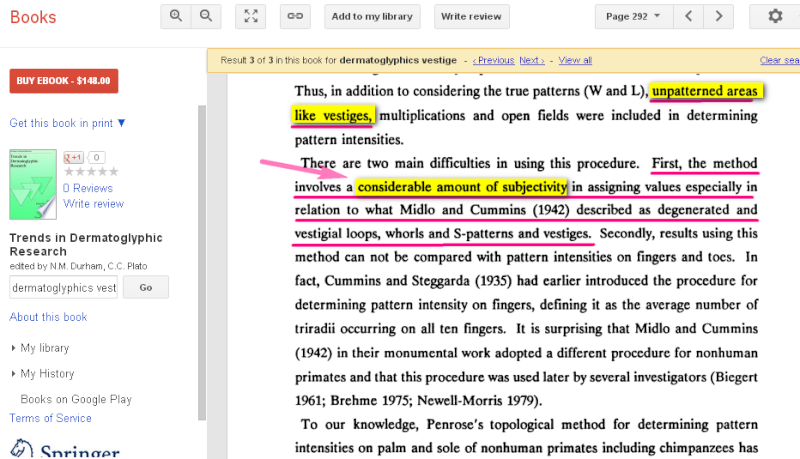

Patti- Posts : 3912
Join date : 2010-07-24
 Re: Is this a comb pattern or no pattern in mercury mount
Re: Is this a comb pattern or no pattern in mercury mount
Patti wrote:...
p.s.:
The second most common location for a vestige is between the ring and little fingers.
p.p.s:
Cummins & Midlo say that they 'may' be found in the two ways you have described, and those are the more obvious, but is certainly not limited to those to examples. They start out their description with the fact that a vestige only looks like a pattern. In other words, it only needs to have features that appear like a pattern. The fact that they don't fit a particular set of rules is what makes them a vestige. Anand's sample obviously has converging ridges in a small space, another of the possibilites mentioned by Cummins & Midlo. Penrose, as quoted above, states they may or may not need to be even noted and that the thenar configuration is the more likely to be made note of.
From your response, I think that you have only observed the thenar vestige in practice.
Patti, your reference to your Penrose quote is pure fantasy... because in that quote Penrose does not refer to the 'vestige' at all.
And please substantiate why you think that Cummins & Midlo have presented a "list" of possibilities... because I have now described with 2 quotes that they have described only two possibilities.
PS. By the way, the statistics shared by Cummins & Midlo on page 116 tot 118 suggest that incomplete loops (for example where a triradius is missing) have probably been counted as a vestiges in their statistics.
 Re: Is this a comb pattern or no pattern in mercury mount
Re: Is this a comb pattern or no pattern in mercury mount

From "Dermatoglyphics in Medical Disorders"
Notice the references at the bottom (page 42) for 'vestige with a tendency toward a loop'. A loop is made up of recurving ridges. The only ridges that do not flow in the general direction of surrounding ridges are the recurves. So, for a vestige to have a tendency toward a loop it may be missing the recurves - which could result in many rods coming to a dead end (typically a comb). If the rods are met by an irregular angle of ridges but not separated or closed off by them, we have the sample that Anand has offered. A vestige with a tendency toward a loop may also have the appearance of recurves but on closer examination they are not really clearly defined. Again, as mentioned above, the description for a vestige is wide ranging and subjective or vague as it's not a true pattern and doesn't conform to true pattern rules.

Patti- Posts : 3912
Join date : 2010-07-24
 Re: Is this a comb pattern or no pattern in mercury mount
Re: Is this a comb pattern or no pattern in mercury mount
Patti, I think Schaumann & Alter's work is most specific regarding the 'vestige' in the interdigital zone below the fingers; see: Dermatoglyphics in Medical Disorders, page 42 - which includes two variants of a 'vestige' (E: one with a tendency towards a loop with an abortive c line, plus F: one with an abortive main line without a tendency towards a loop... but I think it is ESSENTIAL here to notice that BOTH of their 'vestige' examples display an 'abbortive c line'!!):
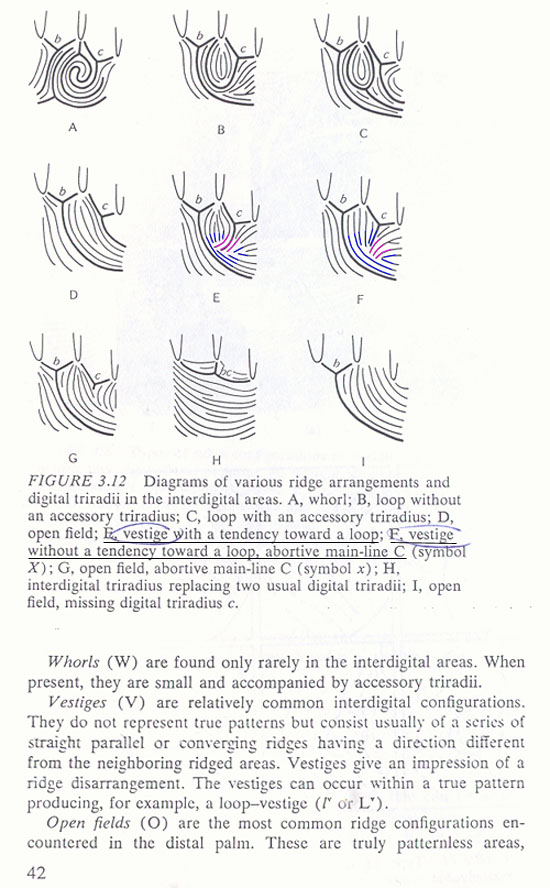
I have highlightened the ridge systems for those two 'vestige' examples with pink color, which shows that in those cases at 3 sides of the pink ridges we can observed blue ridge systems that have a different direction compared to the pink ridges... which shows a clear parallel regarding my observation regarding the example that I have presented earlier (though in that example these different oriented ridge systems were found at all sides of the 'vestige'), see:

Now, going back to Anand's example... even when I use a more loose definition for a 'vestige', I still can not find a ridge system that shows a likewise characteristic (featured with surrounding ridge systems that have a different orientation).
And thus I prefer to conclude that because of the 'parallel' nature of ALL ridges inside Anand's example, formally one can not speak of a 'vestige'... because the direction of the ridges basically shows a likewise orientation as seen in an 'open field' (which is not the case in Schaumann & Alter's two examples!).

 Re: Is this a comb pattern or no pattern in mercury mount
Re: Is this a comb pattern or no pattern in mercury mount

Here's another reference from a Google search. A "vestige fan". That would most likely be a group of rods


Patti- Posts : 3912
Join date : 2010-07-24
 Re: Is this a comb pattern or no pattern in mercury mount
Re: Is this a comb pattern or no pattern in mercury mount
Martijn (admin) wrote:
Thanks for uploading the examples from Schaumann & Alter - they show that these are only examples - there are many, many possibilites.

Patti- Posts : 3912
Join date : 2010-07-24
 Re: Is this a comb pattern or no pattern in mercury mount
Re: Is this a comb pattern or no pattern in mercury mount
Patti wrote:
From "Dermatoglyphics in Medical Disorders"
Notice the references at the bottom (page 42) for 'vestige with a tendency toward a loop'. A loop is made up of recurving ridges. The only ridges that do not flow in the general direction of surrounding ridges are the recurves. So, for a vestige to have a tendency toward a loop it may be missing the recurves - which could result in many rods coming to a dead end (typically a comb). If the rods are met by an irregular angle of ridges but not separated or closed off by them, we have the sample that Anand has offered. A vestige with a tendency toward a loop may also have the appearance of recurves but on closer examination they are not really clearly defined. Again, as mentioned above, the description for a vestige is wide ranging and subjective or vague as it's not a true pattern and doesn't conform to true pattern rules.
Patti, again, a 'comb' is only made by ridges that join a ridge at a right angle; see Loesch's definition on page 126:
"Comb - a formation in which three or more parallel ridges join another ridge almost at right angles to their direction."
And there is no such pattern in Anand's example; because in all ridges that make a connection (plus all terminating ridges) there is no ridge involved that is located at a right angle... like is for example seen in figure 3.5F on page 35 of Schaumann & Alter's work (on page 28 you can find their reference that figure 3.5F includes a comb).
And thus Anand's example does for sure not include a 'comb'.
PS. Again, the 'comb' is ranked only under the 'minutiae' so I don't understand why you continue to make the suggestion that Anand's example includes a combination of a 'vestige-comb'... because that is like saying that this year the quality of the apple-pears were very good (because there are only 'apples' and 'pears'... but not 'apple-pears'). Your 'vestige-comb' appears to be your latest fantasy-concept... directly resulting from Anand's question.
Because combs play no role in pattern classification at all (combs only matter in the perspective of the minutiae).
 Re: Is this a comb pattern or no pattern in mercury mount
Re: Is this a comb pattern or no pattern in mercury mount

I think you have traced the vestiges incorrectly as you have included ridges that are part of a normal triradius and ridges on either side. The only pattern that forms over a triradius is the tented arch formation. The vestige formation is totally between triradii c and b (in these examples).

Patti- Posts : 3912
Join date : 2010-07-24
 Re: Is this a comb pattern or no pattern in mercury mount
Re: Is this a comb pattern or no pattern in mercury mount
Martijn (admin) wrote:Patti wrote:
From "Dermatoglyphics in Medical Disorders"
Notice the references at the bottom (page 42) for 'vestige with a tendency toward a loop'. A loop is made up of recurving ridges. The only ridges that do not flow in the general direction of surrounding ridges are the recurves. So, for a vestige to have a tendency toward a loop it may be missing the recurves - which could result in many rods coming to a dead end (typically a comb). If the rods are met by an irregular angle of ridges but not separated or closed off by them, we have the sample that Anand has offered. A vestige with a tendency toward a loop may also have the appearance of recurves but on closer examination they are not really clearly defined. Again, as mentioned above, the description for a vestige is wide ranging and subjective or vague as it's not a true pattern and doesn't conform to true pattern rules.
Patti, again, a 'comb' is only made by ridges that join a ridge at a right angle; see Loesch's definition on page 126:
"Comb - a formation in which three or more parallel ridges join another ridge almost at right angles to their direction."
And there is no such pattern in Anand's example; because in all ridges that make a connection (plus all terminating ridges) there is no ridge involved that is located at a right angle... like is for example seen in figure 3.5F on page 35 of Schaumann & Alter's work (on page 28 you can find their reference that figure 3.5F includes a comb).
And thus Anand's example does for sure not include a 'comb'.
PS. Again, the 'comb' is ranked only under the 'minutiae' so I don't understand why you continue to make the suggestion that Anand's example includes a combination of a 'vestige-comb'... because that is like saying that this year the quality of the apple-pears were very good (because there are only 'apples' and 'pears'... but not 'apple-pears'). Your 'vestige-comb' appears to be your latest fantasy-concept... directly resulting from Anand's question.
Because combs play no role in pattern classification at all (combs only matter in the perspective of the minutiae).
You seem to be very confused. I have not once called it a comb. I said it was a vestige of a comb. There's a big difference.
p.s.: I came across research papers online last night that described the comb as a "column" pattern.

Patti- Posts : 3912
Join date : 2010-07-24
 Re: Is this a comb pattern or no pattern in mercury mount
Re: Is this a comb pattern or no pattern in mercury mount
Patti wrote:"Trends in Dermatoglyphic Research" confirms the lack of guidelines and definitive rules for a vestige in the description that their determination is "subjective".
No Patti, I think you're misreading things again; because that passage basically only describes that the scoring system presented by Cummins & Midlo (see picture below) is more subjective than Penrose's topological formula: T = L + D -1.
The assessment aspect of the 'vestige' itself is not discussed there.

And actually, the words 'vestigial whorls' and 'vestigial loops' relate to specified whorl- and loops variant that also have clearly defined characteristics; for example: 'vestigial whorls' represent Ws and Wc in the picture below (source: 'Dermatoglyphics: An International Perspective' edited by Jamshed Mavalwala).
PS. I think this confirms my view that in the field of dermatoglyphics there is never much ground to describe things as 'subjective'... unless one does not respect & follow the guidelines by detail.
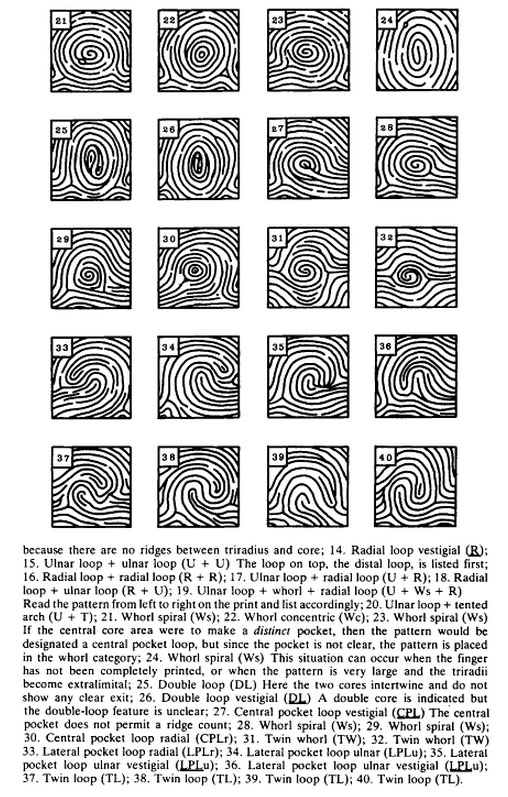
 Re: Is this a comb pattern or no pattern in mercury mount
Re: Is this a comb pattern or no pattern in mercury mount
The link above shows examples of the thenar mount vestiges. Notice how in Fig. 13 b there is only a slight wave to the ridges and not a distinct angle. A vestige does not require distinct angles to the flow of ridges as you have tried to claim.
This link also shows the configuration called a 'column'.

Patti- Posts : 3912
Join date : 2010-07-24
 Re: Is this a comb pattern or no pattern in mercury mount
Re: Is this a comb pattern or no pattern in mercury mount
Patti wrote:Martijn (admin) wrote:Patti wrote:
From "Dermatoglyphics in Medical Disorders"
Notice the references at the bottom (page 42) for 'vestige with a tendency toward a loop'. A loop is made up of recurving ridges. The only ridges that do not flow in the general direction of surrounding ridges are the recurves. So, for a vestige to have a tendency toward a loop it may be missing the recurves - which could result in many rods coming to a dead end (typically a comb). If the rods are met by an irregular angle of ridges but not separated or closed off by them, we have the sample that Anand has offered. A vestige with a tendency toward a loop may also have the appearance of recurves but on closer examination they are not really clearly defined. Again, as mentioned above, the description for a vestige is wide ranging and subjective or vague as it's not a true pattern and doesn't conform to true pattern rules.
Patti, again, a 'comb' is only made by ridges that join a ridge at a right angle; see Loesch's definition on page 126:
"Comb - a formation in which three or more parallel ridges join another ridge almost at right angles to their direction."
And there is no such pattern in Anand's example; because in all ridges that make a connection (plus all terminating ridges) there is no ridge involved that is located at a right angle... like is for example seen in figure 3.5F on page 35 of Schaumann & Alter's work (on page 28 you can find their reference that figure 3.5F includes a comb).
And thus Anand's example does for sure not include a 'comb'.
PS. Again, the 'comb' is ranked only under the 'minutiae' so I don't understand why you continue to make the suggestion that Anand's example includes a combination of a 'vestige-comb'... because that is like saying that this year the quality of the apple-pears were very good (because there are only 'apples' and 'pears'... but not 'apple-pears'). Your 'vestige-comb' appears to be your latest fantasy-concept... directly resulting from Anand's question.
Because combs play no role in pattern classification at all (combs only matter in the perspective of the minutiae).
You seem to be very confused. I have not once called it a comb. I said it was a vestige of a comb. There's a big difference.
p.s.: I came across research papers online last night that described the comb as a "column" pattern.
Patti, my problem here is that you appear to have developed some kind of 'vocabulary-language' that is resulting from your rather associate approach.
Because in your first response to Anand you actually described his example as:
"a vestige bordering on a comb"
Patti, we have been discussing things now for a while... but I still have no idea what you actually mean with those words; and to me this sounds like an entirely subjective language on it's own.
(I also have no idea what "a vestige of a comb" means, and I don't understand how your report about a 'column' could help me out here)
Do I really have to ask you to explain everything by detail? How much longer do you want me to continue like this???
By the way, you also didn't respond to Anand's request for further explanation:
https://www.modernhandreadingforum.com/t2557p15-is-this-a-comb-pattern-or-no-pattern-in-mercury-mount#27682
And meanwhile, you appear to have no awareness that you are using the scientifical materials in a rather associative manner, and whenever I point out to the problems resulting from your aproach... you repond with simple denial + misleading suggestions that I have misunderstood things or got confused.
In your response you didn't explain anything at all... and thus I can only perceive your feedback above as rather personal and entirely subjective.
 Re: Is this a comb pattern or no pattern in mercury mount
Re: Is this a comb pattern or no pattern in mercury mount
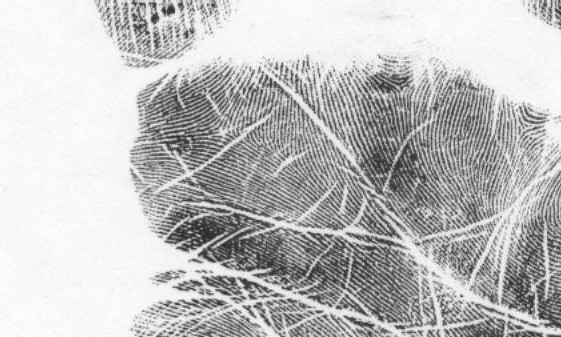
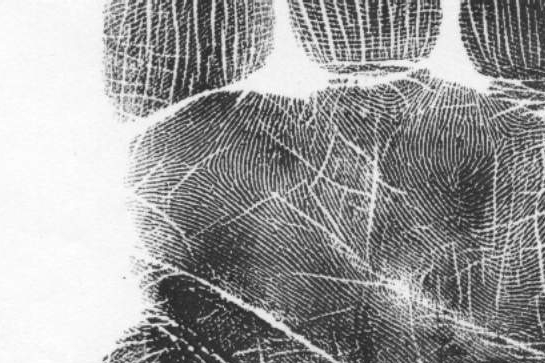
Here are two examples from my collection. I would describe the area in interdigital II in the top photo as a vestige and in the bottom image an open field.
To describe both as open fields would then negate the fact there is a disturbance in the ridges in the top image that suggest the construction of a configuration that is more like a comb or a raja loop.

Patti- Posts : 3912
Join date : 2010-07-24
Page 2 of 3 •  1, 2, 3
1, 2, 3 
 Similar topics
Similar topics» career line and fish on the mercury mount
» Many Tented Archs or Accidental loops on fingers ? Peacock eye on Mercury mount..
» A Pattern of Crossing Headlines
» I got many crosses on mount of saturn and mount of apollo
Modern Hand Reading Forum - Discover the language of your hands: palm reading & palmistry forum! :: III - MODERN HAND READING - Various systems for reading hands! :: IIIa - Modern Palmistry: general topics, questions :: IIIg - Dermatoglyphics + fingerprints






» Teacher square on my Jupiter mount
» Handreading International Conference 2024
» Can anyone read it for me?
» Are there any signs in the hands that you are a twin flame?
» Square on Marriage line
» Cross in mount Jupiter
» clinodactyly: top phalanges bending towards Mercury finger
» Can anybody please read this hand
» Nisha Ghai
» Absolutely non-sense career till now
» Fate Destiny Line -
» VIII - Palmistry books TOP 100 - listed by 'Amazon Sales Rank'!
» Stewart Culin - Palmistry in China and Japan
» Herbert Giles - Palmistry in China